|
Author
|
Topic: History behind NA Rockwell Apollo 11 lucite?
|
Gtsmithson
Member Posts: 19
From: United Kingdom
Registered: Jun 2018
|
 posted 07-26-2019 09:50 AM
posted 07-26-2019 09:50 AM
   
I have just acquired this vintage North American Rockwell lucite and I am seeking further info about it. I was wondering if others have come across this type of lucite before?Hope that you can help me with finding out more. 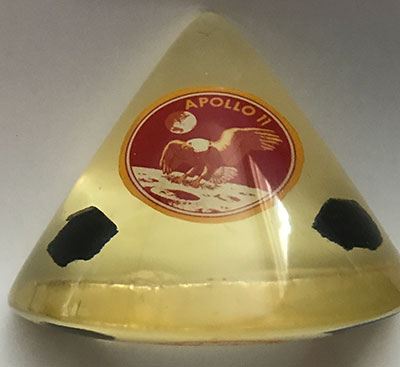 |
Chuckster01
Member Posts: 873
From: Orlando, FL
Registered: Jan 2014
|
 posted 07-26-2019 02:40 PM
posted 07-26-2019 02:40 PM
   
I am curious what details you already have and how you know it is from Rockwell? |
Gtsmithson
Member Posts: 19
From: United Kingdom
Registered: Jun 2018
|
 posted 07-26-2019 02:59 PM
posted 07-26-2019 02:59 PM
   
Source of acrylic was a Kelly Perkins.These acrylics in those days never came with any documentation as they were given away as freebees and no one would dare to ask for provenance in those days — especially if they were done officially. Possibly Rockwell employee made, as opposed to Rockwell made. |
Chuckster01
Member Posts: 873
From: Orlando, FL
Registered: Jan 2014
|
 posted 07-26-2019 07:35 PM
posted 07-26-2019 07:35 PM
   
Almost every company made item even from early Apollo missions are labeled in someway with what it is. I have posted a Lucite with flown heat shield from the Apollo 8 mission and it is clearly labeled North American Rockwell (Lot 59) that is why I asked why you thought it was from North American Rockwell? And if homemade there could be anything inside even charcoal from the grill? I would not know how to tell. |
Gtsmithson
Member Posts: 19
From: United Kingdom
Registered: Jun 2018
|
 posted 07-27-2019 04:08 AM
posted 07-27-2019 04:08 AM
   
In hand, it's obvious that it's not charcoal. This piece was from a lot and one of a number of lucites of various missions. Others have seen these before and say it's legit. |
Chuckster01
Member Posts: 873
From: Orlando, FL
Registered: Jan 2014
|
 posted 07-27-2019 04:42 AM
posted 07-27-2019 04:42 AM
   
I am just jaded by the vast number of fake collectible that find there way to market. After shredding thousands of dollars worth of fake German autographs (from my early collection) and seeing dozens of Lucite displays with no or questionable provenance. Flown items and components that where never flown, components listed from the space program that are from really aircraft parts and it never seems to end. If there is a dollar to be made someone will fake it and this started in the 1960s. Just because something is old does not guarantee that it is real. Since I started the auctions at the American Space Museum, I have sent three people to the state's attorney for forgery, trashed dozens of fake items (with the permission of the consignor) and sent several documented fakes back to the owners to be resold to a sucker somewhere because legally I could do nothing else. I am so jaded that I will not purchase anything that is not sold with solid and proven documentation. I have thrown so much money in the trash with this hobby that I consider all items fake until proven real. Any collector who find an item in their collection is a fake and does not destroy it is just as bad as the forger who created it. But that just me. |
Gtsmithson
Member Posts: 19
From: United Kingdom
Registered: Jun 2018
|
 posted 07-27-2019 04:47 AM
posted 07-27-2019 04:47 AM
   
That doesn’t make this piece fake.This Apollo 11 lucite was part of a lot of lucites made in the same way that included an Apollo 7, that Apollo 7 had a Rockwell label. |
Cozmosis22
Member Posts: 968
From: Texas * Earth
Registered: Apr 2011
|
 posted 07-27-2019 08:51 AM
posted 07-27-2019 08:51 AM
  
quote:
Originally posted by Chuckster01:
I am so jaded that I will not purchase anything that is not sold with solid and proven documentation.
Thanks for your steadfast determination to keep the hobby clean and honest. Agreed about destroying fakes that we may come across. Without any written documentation the Apollo 11 lucite pictured above is a nice odd paperweight. It is apparently something else to the current owner and that is A-OK too. |
Gtsmithson
Member Posts: 19
From: United Kingdom
Registered: Jun 2018
|
 posted 07-27-2019 09:39 AM
posted 07-27-2019 09:39 AM
   
It is not “something else” to me; I consider this to be a legit Apollo 11 piece and Chuck has not given any constructive evidence to suggest otherwise (apart from implying that I should destroy it). An identically made piece for Apollo 7 has the NA Rockwell label. |
Cozmosis22
Member Posts: 968
From: Texas * Earth
Registered: Apr 2011
|
 posted 07-27-2019 10:35 AM
posted 07-27-2019 10:35 AM
  
Does the Apollo 7 NAR label state what is encased in the lucite? Hopefully it does.
Both of those are likely period pieces from the 60s but without something more than verbal provenance there is no way to know if they contain actual flown spacecraft parts. |
Gtsmithson
Member Posts: 19
From: United Kingdom
Registered: Jun 2018
|
 posted 07-27-2019 11:19 AM
posted 07-27-2019 11:19 AM
   
Vintage lucites tend not to state what is contained within. Below is label for the Apollo 7. 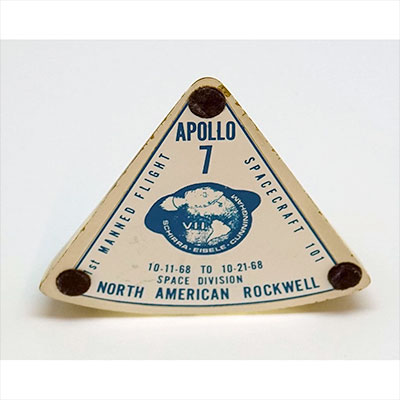 Apollo 9. Appears to be from same range and series as the Apollo 11. 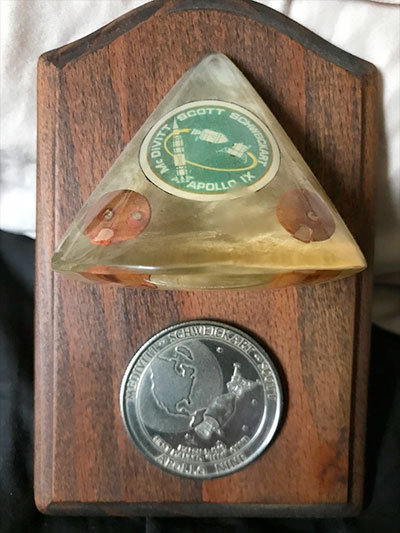 |
denali414
Member Posts: 593
From: Raleigh, NC
Registered: Aug 2017
|
 posted 07-27-2019 12:14 PM
posted 07-27-2019 12:14 PM
   
That was going to be my question — the North American Rockwell lucites have an embedded label on bottom stating from North American Rockwell. Had not realized there were any without the label like the Apollo 7 you posted. |
Chuckster01
Member Posts: 873
From: Orlando, FL
Registered: Jan 2014
|
 posted 07-27-2019 06:05 PM
posted 07-27-2019 06:05 PM
   
For the record I never said your lucite was fake. I said without some provenance it is hard to prove one way or another. Your lucite is a great old piece but who made it, what it contains and the history of the pieces inside are all speculative and I hate to say it but the same would apply to the Apollo 9 lucite. It's a great display but the plugs inside could have been production spares. And for the record, lucites of the period did sometimes document all of the provenance when manufactured. For example, this Apollo 8 lucite from North American Rockwell (sorry for the poor photography). 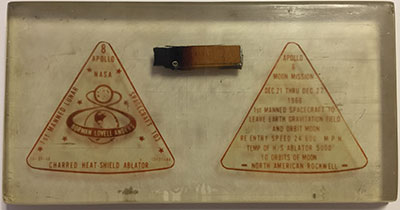 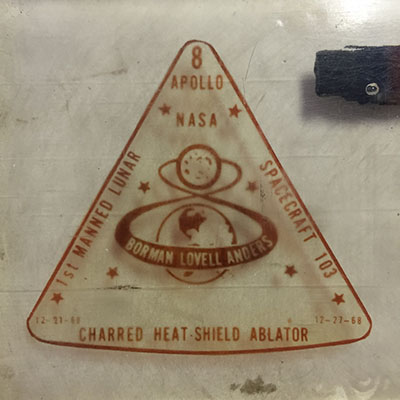
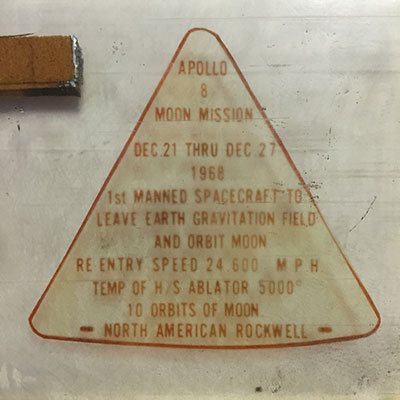
|
fredtrav
Member Posts: 1673
From: Birmingham AL
Registered: Aug 2010
|
 posted 07-27-2019 06:12 PM
posted 07-27-2019 06:12 PM
   
One thing the Apollo 11 lucite does have going for it is the age. When this was apparently made, there was not a big market for this sort of thing. It would not have been worth much so there was no need to fake it. Provenance is always a problem with these and might make the piece worth less, but no reason to believe it is not genuine. |
Gtsmithson
Member Posts: 19
From: United Kingdom
Registered: Jun 2018
|
 posted 07-28-2019 02:46 AM
posted 07-28-2019 02:46 AM
   
You’re implying as such.
FYI the Apollo 9 is from collection of Ray Larson, NASA chief engineer, I have a source on that one.
Re provenance / COAs, etc, it wasn’t thought a requirement at the time, which is why these rarely come with letters, paperwork, etc. quote:
Originally posted by Chuckster01:
For the record I never said your lucite was fake. I said without some provenance it is hard to prove one way or another. Your lucite is a great old piece but who made it, what it contains and the history of the pieces inside are all speculative and I hate to say it but the same would apply to the Apollo 9 lucite. It's a great display but the plugs inside could have been production spares. And for the record, lucites of the period did sometimes document all of the provenance when manufactured. For example, this Apollo 8 lucite from North American Rockwell (sorry for the poor photography).  

|
Go4Launch
Member Posts: 542
From: Seminole, Fla.
Registered: Jul 2003
|
 posted 07-28-2019 06:50 AM
posted 07-28-2019 06:50 AM
   
Ray Larson worked for Rockwell, not NASA and his correct title was lead engineer. |
Gtsmithson
Member Posts: 19
From: United Kingdom
Registered: Jun 2018
|
 posted 07-28-2019 07:12 AM
posted 07-28-2019 07:12 AM
   
Sorry, yes Rockwell International, not NASA. He was also RI's VP too.Lead/Chief mean the same, only seen the word ”Chief,” not “Lead” re. Larson title. 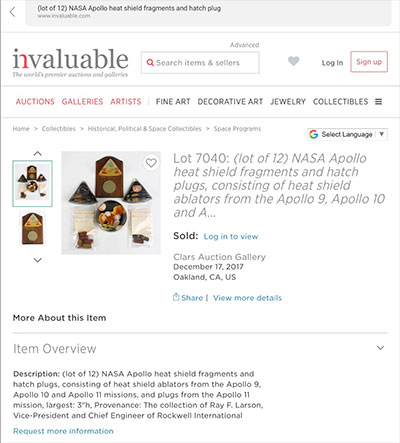 |
denali414
Member Posts: 593
From: Raleigh, NC
Registered: Aug 2017
|
 posted 07-28-2019 11:27 AM
posted 07-28-2019 11:27 AM
   
quote:
Originally posted by fredtrav:
It would not have been worth much...
While agree "back then" they were not worth as much, I'd also say this applies to the difference from "flown" ablative plugs and heat shields to "non-flown."Some of these Lucites could have been made for a much larger audience or workers and been made from material not flown, but just used in program or laying around at end. There was not much difference or interest as you said in the material back then. |
Gtsmithson
Member Posts: 19
From: United Kingdom
Registered: Jun 2018
|
 posted 07-28-2019 01:00 PM
posted 07-28-2019 01:00 PM
   
The material within lucites more often than not display evidence of having been used, i.e. charring, screw marks, etc; they would have been removed post flight during decommissioning, decontamination, etc. |
denali414
Member Posts: 593
From: Raleigh, NC
Registered: Aug 2017
|
 posted 07-28-2019 05:50 PM
posted 07-28-2019 05:50 PM
   
This document has more good research on the ablative plugs, heat shield etc from Apollo 11 and other missions (especially page 6-15). Plugs had to be tested before ever used, so of course there are unflown plugs and shield material that is "burned," but never flown. The heat shield was manufactured by first bonding the fiberglass honeycomb to a stainless steel honeycomb substructure with HT-424 adhesive tape. The bond line was inspected to ensure that a good bond had been achieved, and the assembly was then cured. After curing, each of the 370,000 honeycomb cells was manually filled with Avcoat ablator using a device similar to a high pressure caulking gun. The filled honeycomb was furnace cured, after which it was finish-machined on a numerically controlled lathe. The heat shield was X-ray inspected to find any voids which were subsequently drilled out and refilled with Avcoat ablator material. |
SpaceAholic
Member Posts: 4437
From: Sierra Vista, Arizona
Registered: Nov 1999
|
 posted 07-28-2019 08:44 PM
posted 07-28-2019 08:44 PM
   
quote:
Originally posted by denali414:
Plugs had to be tested before ever used, so of course there are unflown plugs and shield material that is "burned," but never flown.
The only unflown heatshield material legitimately exhibiting ablation (or "burned" as you characterize it) would have been arc jet tested and that was conducted in vary limited manner (early in the program preceding the block II manned missions). |
Spacepsycho
Member Posts: 818
From: Huntington Beach, Calif.
Registered: Aug 2004
|
 posted 09-12-2019 12:14 PM
posted 09-12-2019 12:14 PM
   
I have a few hundred vintage resin displays with flown material embedded from the Gemini and Apollo missions. I obtained 95% directly from those who worked on the programs or their families. I was given the names of the gentlemen who made them, in some cases these displays were created by program workers with and without permission by management and some were ordered by management to be given away to others in the company.In my opinion, the Apollo 11 CM display with the two pieces embedded is absolutely authentic and if you know what you're looking at, there are telltale signs of originality. These full CM resins were not easy to make, the creator took a lot of time and careful prep to make them and their imperfections are a strong indicator of originality. The Apollo 8 display is beautiful, the half CM resin displays are well known as having been produced by NAA and their provenance is iron clad. The hockey puck lucites produced by NASA lend themselves to being faked because the same manufacturing process and materials are used today. But like Scott said, if you know how the ablator material charred, it's difficult to fake because of the heat and time required to forge the burn depth and pattern. After buying a large collection of custom resin pieces from a NAA spacecraft inspector, he explained that the dome resin displays were created using RTV as a mold and the process required to create them. Remember, in the olden days these weren't worth anything like they are today. These resins had air bubbles, imperfections, crooked placement and were not done by professionals. These were primarily done for workers, management, NASA folks and VIPs who supported the program. I have some resin displays with up to eight individually poured layers. Some resins have pieces of company stationary cut into small strips with a typed description and embedded with the artifact. I have a full bottom plug embedded in a complete round CM shape with a small piece of paper that has the mission. Some just have the S/C number on the paper, while others used a decal, sticker or patch to designate the mission. Some had a glitter background, others had a black resin layer background and sometimes it was up to the materials on hand that determined how the batch of resins came out. I purchased a vintage resin with 10 small parts removed from the Apollo 11 spacecraft. I did my research and was able to prove the authenticity of the piece. Another two pieces I purchased from eBay had no provenance, everyone passed on them, but the way they were produced screamed originality. I was able to contact the widow of an RCA radio tech, who confirmed that Ron Evans was a frequent dinner guest and friend of her hubby. The RCA tech embedded an Apollo 17 flown cereal cube given to him by Ron, in resin using a Gerber baby food jar as a mold. Then I was able to obtain a letter from an oil company exec who was given two displays by the man who designed the A7LB helmet. To dismiss or reject every resin display because it doesn't have iron clad provenance is foolish. All you have to do is learn how the vintage displays were produced and it's kind of a no brainer. Obviously some resins are easier to prove than others, but I've seen, handled and owned many many hundreds of vintage resins and rarely have I ever found a faked one. |
mode1charlie
Member Posts: 1169
From: Honolulu, HI
Registered: Sep 2010
|
 posted 09-12-2019 04:51 PM
posted 09-12-2019 04:51 PM
   
Do you have a website that documents all the different types and your degree of confidence in their authenticity? That would be a really valuable resource for collectors.I have "Apollo XI Flown Mylar" and Apollo 8 heatshield/kapton lucites that I have not yet seen definitive provenance for (though they are both types not uncommonly seen), and so finding out who/where/when they were produced would be of great interest to me. Thanks. |
Ianhetho
Member Posts: 109
From: Bogangar NSW Australia
Registered: May 2018
|
 posted 09-12-2019 05:04 PM
posted 09-12-2019 05:04 PM
   
Agreed, a web page would be great. |
denali414
Member Posts: 593
From: Raleigh, NC
Registered: Aug 2017
|
 posted 09-12-2019 05:36 PM
posted 09-12-2019 05:36 PM
   
Count me in also wanting a web page — or even a thread here with pictures would be a great help for us beginners in learning the "real" from fake and the history behind these lucites we collect. |
thisismills
Member Posts: 263
From: Michigan
Registered: Mar 2012
|
 posted 09-12-2019 06:27 PM
posted 09-12-2019 06:27 PM
   
Ray, thanks for sharing that detailed post with your information here.For those wanting more, even though I have spent many years working on this website, I've certainly only just begun to scratch the surface with these items. The site's focus has been those heatshield presentations originating from NASA astronauts, flight directors, and support personnel along with managers and engineers from the various contractors (i.e. the recipients of presentations). These acrylics have been sold at auction houses in the last few decades from the original owners or their estates. In general what I have tried to show are those produced with a uniform style and with a specific presentation purpose in mind. Many were manufactured by a third-party under contract to produce and deliver these back to NASA or the contractor. I am currently working on another section with the myriad of other styles made by individuals on their own accord within NASA and the sub-contractors. As you can imagine, this process is taking longer owing to the fact that these styles tend to be less consistent from mission to mission and from program to program. Unfortunately many of these are sold with less provenance and as Ray stated, it takes a keen understanding of how they were produced and the associated context clues to make a judgement on any given item's history. An unfortunate but understandable product of their creation, little thought was given beyond making a souvenir in the movement, which has made our jobs harder as collectors. A few sets of homemade acrylics containing most or all missions from Apollo and Skylab have been sold in the past, so I have no doubt that more are out there and should be documented to the best of our ability. Stay tuned. |
denali414
Member Posts: 593
From: Raleigh, NC
Registered: Aug 2017
|
 posted 09-13-2019 06:06 AM
posted 09-13-2019 06:06 AM
   
Jeff, that is an awesome site you have built — thanks for all the varied pictures, really going to help with research and comparisons. |
Spacepsycho
Member Posts: 818
From: Huntington Beach, Calif.
Registered: Aug 2004
|
 posted 09-13-2019 04:51 PM
posted 09-13-2019 04:51 PM
   
Jeff's site is the best reference out there for the vintage, garage and contractor workers who produced these resin, acrylic and polyester displays. We've chatted about doing a book or some other reference material on the unconventional flown displays.There are so many different styles that are rare or unseen displays, created by guys who worked on the various programs. For instance I have 55 or 60 vintage resins and acrylics with flown Gemini heatshield, bolts, washers and miscellaneous items embedded, that were done in nine different styles. About half are from GT-8 because the spacecraft was extensively disassembled trying to find the cause of the faulty RCS. An electrical engineer who installed the wiring on GT-8, told me how the entire heatshid and one third of the exterior panels were removed when the spacecraft came back to St. Louis. He told me there was a large pile of heatshield material in the corner for everyone to take a piece. Many segments are 4" round, that were cut with a power tool and hole cutter. He said they were begging people to take the heatshield pieces because they didn't want to throw it in the garbage. Shaking my head, imagine if anyone on this board could go back in time. I purchased all of my Gemini pieces from gentlemen and ladies or their families who worked at McDonnell during the program. On the other hand I've purchased more than a few of the Apollo CM shaped resins with flown material at swapmeets, estate sales and from various family members who worked on the Apollo and Shuttle programs at NAA. My latest find a few weeks ago was a display from a gentleman who worked at NAA for 53 years. His family sd me some beautiful stuff including his 7 NAA 10k gold anniversary, the 20-30-40-50 year pins had diamonds. |
mode1charlie
Member Posts: 1169
From: Honolulu, HI
Registered: Sep 2010
|
 posted 09-14-2019 03:21 PM
posted 09-14-2019 03:21 PM
   
I agree 100% that the website Jeff (thisismills) created is an excellent resource! However it only includes, at least for now, heatshield presentations, and there are also some heatshield lucites (for example the Apollo 8 one that I own) that aren't yet on there. |


















